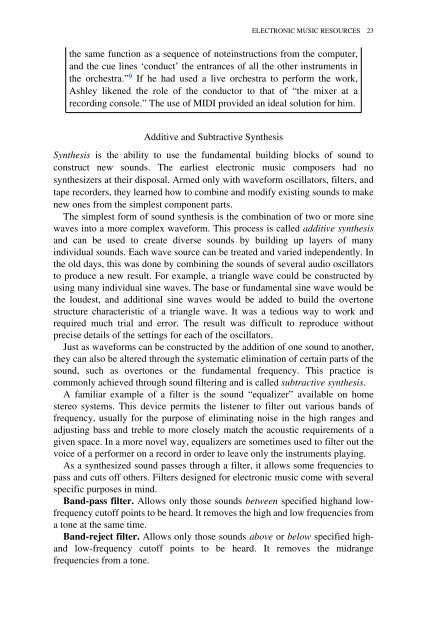Electronic and Experimental Music: Pioneers in ... - Aaaaarg
Electronic and Experimental Music: Pioneers in ... - Aaaaarg
Electronic and Experimental Music: Pioneers in ... - Aaaaarg
Create successful ePaper yourself
Turn your PDF publications into a flip-book with our unique Google optimized e-Paper software.
the same function as a sequence of note<strong>in</strong>structions from the computer,<br />
<strong>and</strong> the cue l<strong>in</strong>es ‘conduct’ the entrances of all the other <strong>in</strong>struments <strong>in</strong><br />
the orchestra.” 9 If he had used a live orchestra to perform the work,<br />
Ashley likened the role of the conductor to that of “the mixer at a<br />
record<strong>in</strong>g console.” The use of MIDI provided an ideal solution for him.<br />
Additive <strong>and</strong> Subtractive Synthesis<br />
ELECTRONIC MUSIC RESOURCES 23<br />
Synthesis is the ability to use the fundamental build<strong>in</strong>g blocks of sound to<br />
construct new sounds. The earliest electronic music composers had no<br />
synthesizers at their disposal. Armed only with waveform oscillators, filters, <strong>and</strong><br />
tape recorders, they learned how to comb<strong>in</strong>e <strong>and</strong> modify exist<strong>in</strong>g sounds to make<br />
new ones from the simplest component parts.<br />
The simplest form of sound synthesis is the comb<strong>in</strong>ation of two or more s<strong>in</strong>e<br />
waves <strong>in</strong>to a more complex waveform. This process is called additive synthesis<br />
<strong>and</strong> can be used to create diverse sounds by build<strong>in</strong>g up layers of many<br />
<strong>in</strong>dividual sounds. Each wave source can be treated <strong>and</strong> varied <strong>in</strong>dependently. In<br />
the old days, this was done by comb<strong>in</strong><strong>in</strong>g the sounds of several audio oscillators<br />
to produce a new result. For example, a triangle wave could be constructed by<br />
us<strong>in</strong>g many <strong>in</strong>dividual s<strong>in</strong>e waves. The base or fundamental s<strong>in</strong>e wave would be<br />
the loudest, <strong>and</strong> additional s<strong>in</strong>e waves would be added to build the overtone<br />
structure characteristic of a triangle wave. It was a tedious way to work <strong>and</strong><br />
required much trial <strong>and</strong> error. The result was difficult to reproduce without<br />
precise details of the sett<strong>in</strong>gs for each of the oscillators.<br />
Just as waveforms can be constructed by the addition of one sound to another,<br />
they can also be altered through the systematic elim<strong>in</strong>ation of certa<strong>in</strong> parts of the<br />
sound, such as overtones or the fundamental frequency. This practice is<br />
commonly achieved through sound filter<strong>in</strong>g <strong>and</strong> is called subtractive synthesis.<br />
A familiar example of a filter is the sound “equalizer” available on home<br />
stereo systems. This device permits the listener to filter out various b<strong>and</strong>s of<br />
frequency, usually for the purpose of elim<strong>in</strong>at<strong>in</strong>g noise <strong>in</strong> the high ranges <strong>and</strong><br />
adjust<strong>in</strong>g bass <strong>and</strong> treble to more closely match the acoustic requirements of a<br />
given space. In a more novel way, equalizers are sometimes used to filter out the<br />
voice of a performer on a record <strong>in</strong> order to leave only the <strong>in</strong>struments play<strong>in</strong>g.<br />
As a synthesized sound passes through a filter, it allows some frequencies to<br />
pass <strong>and</strong> cuts off others. Filters designed for electronic music come with several<br />
specific purposes <strong>in</strong> m<strong>in</strong>d.<br />
B<strong>and</strong>-pass filter. Allows only those sounds between specified high<strong>and</strong> lowfrequency<br />
cutoff po<strong>in</strong>ts to be heard. It removes the high <strong>and</strong> low frequencies from<br />
a tone at the same time.<br />
B<strong>and</strong>-reject filter. Allows only those sounds above or below specified high<strong>and</strong><br />
low-frequency cutoff po<strong>in</strong>ts to be heard. It removes the midrange<br />
frequencies from a tone.












